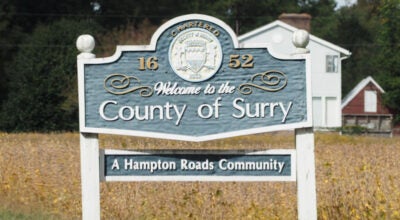Virginia Tech eases Hogweed fears
Published 6:41 pm Tuesday, June 26, 2018
IW alert was carried by Washington Post
By Diana McFarland
Managing editor
Experts at Virginia Tech are trying to damp down concerns about a new invasive plant found in the state, the Giant Hogweed.
Alarm bells went off recently after the plant was found in three counties in Virginia, including a safety alert posted by Isle of Wight County employees on the county website.
The plant has not been found in Isle of Wight County or any county nearby. So far, it’s been detected in Clarke and Fauquier counties in Northern Virginia and Rockingham County in the Shenandoah Valley and the city of Alexandria, according to Virginia Tech. {mprestriction ids=”1,2,3,4,5,6″}
However, Isle of Wight County issued a safety alert on its website, warning of third degree burns and permanent blindness that could result from touching the plant.
“There is a strong possibility that the Giant Hogweed could find its way into the Tidewater/Coastal Virginia area,” according to the Isle of Wight alert.
The county alert was featured in a Washington Post story last week about the invasive plant.
It seems unlikely that it will reach the Tidewater and coastal Virginia area,
since the sightings are where people have intentionally planted the Giant Hogweed, and if it has moved, it was moved on purpose, said Jordan Metzgar, curator of the Massey Herbarium at Virginia Tech.
And while Isle of Wight listed Middlesex County as a sighting, it has not been confirmed there, said Metzgar.
Middlesex County is on the Middle Peninsula, next to Gloucester County.
Metzgar said the plant came to the United States from Southwest Asia in 1917. It was brought to a garden in New York.
It’s not know why it was brought here, and if it was the size or danger factor that is appealing, said Metzgar, referring to the irritating sap the plant produces.
Virginia Tech issued the following statement on Tuesday.
“There’s not cause for widespread worry. It’s growing where it’s been planted from what we’ve seen. We see little evidence of it widely spreading,” said Virginia Tech’s Michael Flessner, an assistant professor and extension weed science specialist who has worked closely with Metzgar to identify that the plants are indeed Giant Hogweed.
Initial management measures have been taken at all four sites, and VDACS will follow up with subsequent site visits.
Giant Hogweed is a Tier 1 noxious weed on VDACS’ Noxious Weed List. A Tier 1 classification means the weed was previously unknown in the Commonwealth. The Department of Conservation and Recreation lists Giant Hogweed as an early detection invasive plant, which means it is not established in Virginia and if found, the goal is to eradicate it before it becomes established.
When exposed to skin, the sap from a Giant Hogweed plant can cause severe skin and eye irritation, painful blistering and potentially permanent scarring. The plant is easily confused with other look alike plants such as cow parsnip, elderberry, and others. People who think they have found Giant Hogweed should take a digital photo of the leaf, stem and flower, being careful to avoid skin contact with the plant. They can report it to the local office of Virginia Cooperative Extension or file an online report here.
Giant Hogweed is a very distinct plant when set against Virginia landscapes and although it has some similar characteristics as cow parsnip, angelica and Queen Anne’s lace, its size sets it apart. It can grow up to 15 feet tall with leaves as large as five feet across but most plants identified in Virginia have been five to 10 feet tall, with largest leaves about two feet across. The white flower cluster contains 50 – 150 flower rays spreading up to two feet across. Giant Hogweed also has purple splotches and coarse, sparse white hairs on the stem. The leaf is more incised and angular than cow parsnip, which giant Hogweed’s closest look alike.
Anyone who suspects they have found Giant Hogweed should take photos, check online to compare the plant to photos, and then contact a Virginia Cooperative Extension agent or file an online report here. Information is available at www.dcr.virginia.gov to learn more about invasive species in Virginia and the ways to prevent spread. People also may contact the VDACS Office of Plant Industry Services at 804-786-3515. {/mprestriction}





